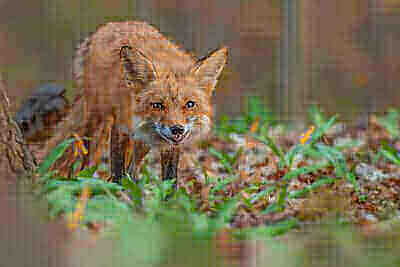Disclosure: We may earn commissions if you purchase products after clicking on a link from our site.
Do you want to hunt a red fox? Would you like to learn how to hunt red fox? The red fox is nocturnal and has a very good sense of smell, eyesight, and hearing. It is also cunning and elusive. Additionally, the red fox is also sneaky, aware of its surroundings, and not easy to track down. In this article, we discuss hunting strategies to have a successful red deer hunt.
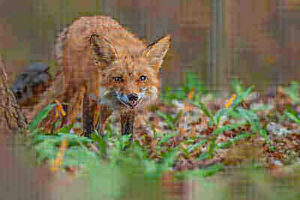
Table of Contents
How To Hunt Red Fox
1. Scouting Red Fox
When scouting for red foxes, keep on the lookout for tracks, scat, and fur. The big males leave heavy tracks. Always study the tracks to determine if they are tracks of heavy and mature males. Before going to physically scout the area, you can use Google Earth or hunting apps like HuntWise, HuntStand, or onX to study the landscape and look for possible den sites, burrows, tall grass, hills, water sources, and valleys where red fox could be found.
Additionally, some hunters use thermal monoculars to scan the fields. With thermal monoculars, they can accurately locate single and paired foxes. This helps them get a good idea of how many red foxes are in the area. The thermal monoculars let you see exactly where they are concentrated, what they are feeding on, and where they are holed up.
Scouting for red foxes is crucial for successful hunting endeavors. Red foxes are adaptable and can inhabit a variety of habitats, including forests, grasslands, and agricultural areas. To scout effectively, hunters search for signs of fox activity such as tracks, scat, and dens.
Tracks can indicate recent movement and provide insights into the fox’s size and direction of travel. Scat can reveal diet preferences and help hunters locate feeding grounds. Dens, often located in brushy or wooded areas, serve as the fox’s shelter and breeding grounds.
Additionally, scouting involves observing the landscape for potential hunting spots and identifying areas with high fox populations. By understanding the fox’s behavior and habitat preferences through scouting, hunters can strategically plan their hunts and increase their chances of success.
2. Predator Calls
Using predator calls can be a highly effective technique when hunting red foxes. These calls mimic the distress sounds of small mammals or birds, attracting curious or hungry foxes looking for an easy meal.
Hunters strategically place themselves downwind of the call location, ensuring that any approaching foxes will not catch their scent. Once the call is activated, it can elicit a response from nearby foxes, drawing them closer to investigate. This method relies on the fox’s instinct to investigate potential prey distress calls, making it a versatile and proven tactic for luring them within range for a shot.
By mastering different call sounds and adjusting their approach based on the fox’s response, hunters can significantly increase their success rates when targeting red foxes in various hunting environments. We did a review of the best predator calls that can be read from this link.
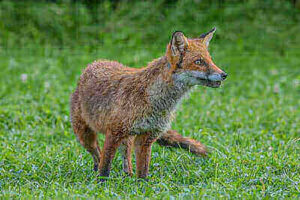
3. Decoys
Using decoys when hunting red foxes can be an effective strategy to attract these elusive predators within range. Decoys, often crafted to resemble injured or distressed prey animals such as rabbits or birds, are strategically placed in areas frequented by foxes, such as field edges or forest clearings.
The realistic appearance and movements of the decoys mimic potential prey in distress, enticing curious foxes to investigate. Hunters typically position themselves downwind of the decoys, hidden from the keen senses of the foxes.
As the fox approaches the decoy, the hunter can carefully aim a clean shot. Decoys add an element of visual stimulation to the hunt, increasing the likelihood of drawing in foxes from a distance. However, success with decoys also requires patience, careful concealment, and a good understanding of fox behavior and habitat preferences.
4. Spot & Stalk Method
The spot and stalk hunting method for red foxes involves patiently observing their habitat from a concealed vantage point, spotting them from a distance, and then carefully stalking within shooting range.
This method requires keen observation skills and a good understanding of fox behavior and habitat preferences. Hunters often scan open fields, forest edges, and brushy areas, looking for the telltale movement or silhouette of a fox.
Once spotted, hunters must cautiously approach while using available cover to remain undetected. Stalking requires slow and deliberate movement, taking advantage of terrain features to conceal the hunter’s approach. It’s crucial to maintain awareness of wind direction to avoid alerting the fox to human scent.
This method can be challenging but rewarding for hunters seeking a close encounter with these wily predators. For more information on hunting methods for red foxes, visit the official website of the U.S. Fish and Wildlife Service: Spot and Stalk Hunting.
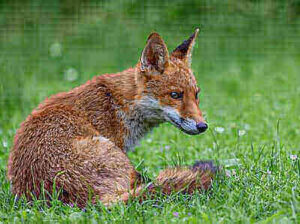
5. Wind Direction
Wind direction plays a crucial role when hunting red foxes, as these animals have an acute sense of smell. Hunters must always position themselves downwind from the area where they expect to encounter foxes.
This ensures that their scent is carried away from the foxes, minimizing the risk of detection. By paying attention to wind direction, hunters can approach their hunting spots without alerting the foxes to their presence, increasing their chances of a successful hunt.
Additionally, being mindful of wind direction allows hunters to plan their stalks effectively, ensuring that they remain undetected as they move closer to their quarry.
6. Hunting With Dogs
Hunting red foxes with dogs is a traditional and effective method that relies on the keen senses and tracking abilities of the canines. Specially trained hunting dogs, such as foxhounds or scent hounds, are used to locate and pursue foxes.
Once the dogs pick up the scent trail, they chase the fox, often driving it toward waiting hunters. This method requires skilled handling of the dogs and coordination among the hunting team. The dogs’ persistent tracking instincts, coupled with their agility and speed, make them valuable assets in flushing out elusive foxes from their hiding spots.
Additionally, hunting with dogs adds an element of excitement and camaraderie to the pursuit, as hunters and their canine companions work together to outsmart the wily foxes. There are dog breeds that are good for hunting and we did a review of the best hunting dog breeds.
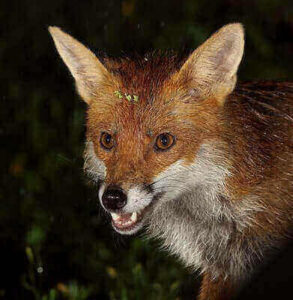
7. Treestands
Setting up treestands can be an effective strategy for hunting red foxes, especially in areas with dense vegetation or varied terrain. By positioning treestands strategically along known fox travel routes or near their dens, hunters can gain a vantage point that offers better visibility and concealment.
When selecting locations for treestands, hunters should consider factors such as prevailing wind direction, proximity to fox activity areas, and natural features that may funnel foxes into specific pathways. Once in the treestand, hunters can patiently wait for foxes to appear, taking advantage of the elevated position to spot them from a distance and make accurate shots.
Additionally, treestands provide a safe and stable platform for hunters to remain undetected and minimize disturbance to the surrounding environment. Overall, setting up treestands can enhance the chances of success when hunting red foxes by improving visibility and increasing the hunter’s tactical advantage.
When hunting red foxes, you can set up several treestands in different directions. This helps when hunting red foxes as it allows you to move from one location to another depending on the wind direction. If you are interested in treestands, we reviewed the best climbing treestands.
8. Bait
Bait can be used to hunt red foxes. A red fox has a very good sense of smell. You can use that to your advantage to hunt red foxes. Smelly fish and other food that red foxes eat like mice, rodents, birds, and amphibians can be used as bait when hunting red foxes. Additionally, you can set up a ground blind that overlooks the bait pile and wait for the fox to come to the bait pile.
Foxes are very cautious and will approach a bait pile with caution. It will not approach the bait pile until it is sure there is no danger. Be patient and wait for the red fox to be convinced of no danger before you take a good shot. If you are interested in ground blinds, we reviewed the best hunting ground blinds on the market today.
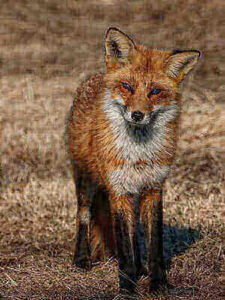
Red Fox Hunting Tips
1. Red fox is nocturnal and often hunts in the late evening until early morning.
2. Red fox has a very good sense of smell and eyesight.
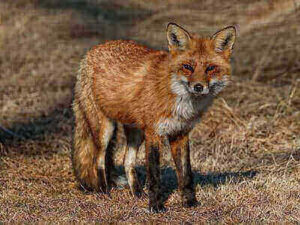
3. Red foxes can be hunted using predator calls like distressed rabbit calls, cottontail calls, jackrabbit calls, hare screams, etc.
4. Spot and stalk hunting method is one of the popular methods of hunting red fox.
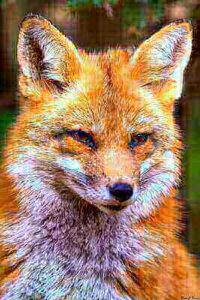
5. When scouting and hunting red foxes, you can use thermal monoculars to scan the fields in search of red foxes.
6. When scouting for red foxes, look for scat, tracks, and the red fur of the fox.
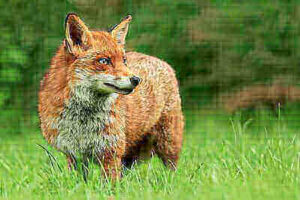
7. When scouting, also listen for vocalizations, especially during the breeding season. They also bark and make yipping sounds.
8. Red fox eats fish, insects, small mammals, fruits, berries, nuts, carrion, earthworms, crawdads, amphibians, and ground-nesting birds and their eggs.
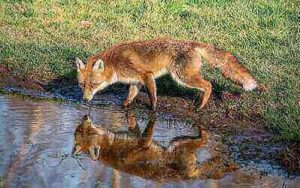
9. Always hunt red fox with the wind in your face.
10. You can use treestands and ground blinds to hunt red foxes.
11. When hunting for red foxes, you can glass from a high elevation using binoculars to spot red foxes.
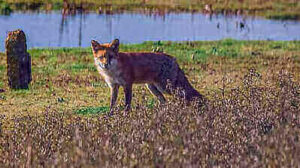
The Bottom Line
Hunting red fox is challenging as it is elusive, sneaky, and nocturnal. Additionally, the red fox has a very good sense of smell, eyesight, and hearing. They use these abilities as part of their defense system against predators.
In this article, we discuss how to successfully hunt red foxes. If you are also interested in hunting wolves, then read how to hunt wolves. You can also read how to hunt fox, how to hunt bobcats, how to hunt coyotes, how to hunt cougars, and how to hunt wolves.
